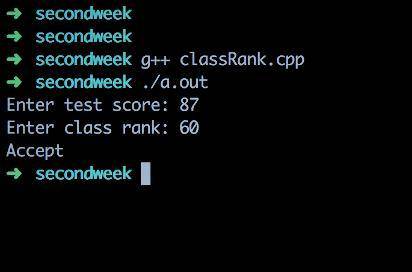
Computers and Technology, 30.05.2020 23:00 AutumnJoy12
In this lab, you use the flowchart and pseudocode found in the figures below to add code to a partially created C++ program. When completed, college admissions officers should be able to use the C++ program to determine whether to accept or reject a student, based on his or her test score and class rank.
// HouseSign. cpp - This program calculates prices for custom made signs.
#include
#include
using namespace std;
int main()
{
// This is the work done in the housekeeping() function
// Declare and initialize variables here
// Charge for this sign
// Color of characters in sign
// Number of characters in sign
// Type of wood
// This is the work done in the detailLoop() function
// Write assignment and if statements here
// This is the work done in the endOfJob() function
// Output charge for this sign
cout << "The charge for this sign is $" << charge << endl;
return(0);
}

Answers: 3


Another question on Computers and Technology

Computers and Technology, 22.06.2019 22:30
You are new to microsoft certification and want to start out by getting a certification geared around windows 8. what microsoft certification should you pursue?
Answers: 1

Computers and Technology, 23.06.2019 01:40
Writing a modular program in visual c++. i am new to this and not sure what i am missing. i am getting the following error: baddate.cpp: in function ‘int main()’: baddate.cpp: 50: 3: error: ‘else’ without a previous ‘if’elsehere are the instructions and code: writing a modular program in c++in this lab, you add the input and output statements to a partially completed c++ program. when completed, the user should be able to enter a year, a month, and a day. the program then determines if the date is valid. valid years are those that are greater than 0, valid months include the values 1 through 12, and valid days include the values 1 through 31.notice that variables have been declared for you.write the simulated housekeeping() function that contains the prompts and input statements to retrieve a year, a month, and a day from the user.include the output statements in the simulated endofjob() function. the format of the output is as follows: month/day/year is a valid date.ormonth/day/year is an invalid date.execute the program entering the following date: month = 5, day = 32, year = 2014. record the output of this program.execute the program entering the following date: month = 9, day = 21, year = 2002. record the output of this /* program name: baddate.cppfunction: this program determines if a date entered by the user is valid.input: interactiveoutput: valid date is printed or user is alerted that an invalid date was entered*/#include bool validatedate(int, int, int); using namespace std; int main(){// declare variablesint year; int month; int day; const int min_year = 0, min_month = 1, max_month = 12, min_day = 1, max_day = 31; bool validdate = true; // this is the work of the housekeeping() method// get the year, then the month, then the daycout< < "enter the year"< > year; cout< < "enter the month"< > month; cout< < "enter the day"< > day; // this is the work of the detailloop() method// check to be sure date is validif(year < = min_year) // invalid yearvaliddate = false; else if (month < min_month || month > max_month) // invalid monthvaliddate = false; else if (day < min_day || day > max_day) // invalid dayvaliddate = false; // this is the work of the endofjob() method// test to see if date is valid and output date and whether it is valid or notif(validdate == true); {// output statementcout<
Answers: 1


Computers and Technology, 23.06.2019 17:30
When making changes to optimize part of a processor, it is often the case that speeding up one type of instruction comes at the cost of slowing down something else. for example, if we put in a complicated fast floating-point unit, that takes space, and something might have to be moved farther away from the middle to accommodate it, adding an extra cycle in delay to reach that unit. the basic amdahl's law equation does not take into account this trade-off. a. if the new fast floating-point unit speeds up floating-point operations by, on average, 2ă—, and floating-point operations take 20% of the original program's execution time, what is the overall speedup (ignoring the penalty to any other instructions)? b. now assume that speeding up the floating-point unit slowed down data cache accesses, resulting in a 1.5ă— slowdown (or 2/3 speedup). data cache accesses consume 10% of the execution time. what is the overall speedup now? c. after implementing the new floating-point operations, what percentage of execution time is spent on floating-point operations? what percentage is spent on data cache accesses?
Answers: 2
You know the right answer?
In this lab, you use the flowchart and pseudocode found in the figures below to add code to a partia...
Questions

Mathematics, 02.10.2020 14:01


Mathematics, 02.10.2020 14:01

Mathematics, 02.10.2020 14:01

English, 02.10.2020 14:01

Mathematics, 02.10.2020 14:01



Mathematics, 02.10.2020 14:01

Mathematics, 02.10.2020 14:01


Mathematics, 02.10.2020 14:01

Mathematics, 02.10.2020 14:01

Chemistry, 02.10.2020 14:01

English, 02.10.2020 14:01


Mathematics, 02.10.2020 14:01



Mathematics, 02.10.2020 14:01




